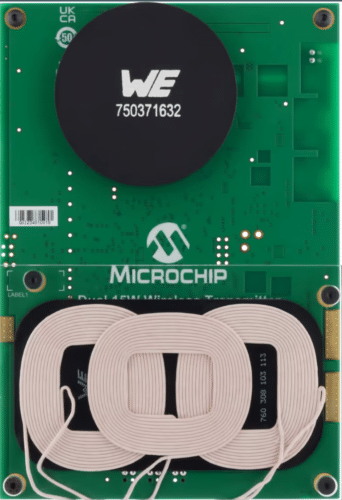The reference design supports Qi 2.0 with a dual-pad wireless power transmitter, offering flexibility and security across various applications.

Wireless power transmitters are increasingly crucial in today’s technology-driven world due to their convenience and ability to eliminate the need for physical cables and connectors. This improves the aesthetic appeal of spaces by reducing clutter and enhances the durability of devices by minimizing wear and tear on physical connectors. Furthermore, wireless charging offers safety advantages by reducing the risk of electric shock and short circuits. The integration of wireless charging technology into a wide range of devices, from smartphones to electric vehicles, is a testament to its innovative potential. Standardized protocols like Qi ensure compatibility across different devices, making wireless charging more accessible and convenient for users. Overall, the need for wireless power transmitters is driven by their ability to provide a seamless, safe, and efficient charging experience, which is becoming increasingly important in our daily lives.
The reference design of Qi 2.0 dual-pad wireless power transmitter by Microchip features a dual-pad multi-coil wireless power transmitter controlled by a single dsPIC33 Digital Signal Controller (DSC), supporting both Extended Power Profile (EPP) and Magnetic Power Profile (MPP) of Qi 2.0. The DSC’s flexible software architecture allows optimized software to manage a combination of EPP and MPP with one controller. As an automotive-grade reference design, it includes CryptoAuthentication to meet the security requirements of the standard. The design comprises the dsPIC33 DSC, the Trust Anchor TA100/TA010 secure storage subsystem provisioned as a licensed Wireless Power Consortium (WPC) Manufacturer Certificate Authority (CA), and other components depicted in the block diagram. We provide design files and software source code under the appropriate terms and conditions for a seamless design process and first-pass success.
to meet the security requirements of the standard. The design comprises the dsPIC33 DSC, the Trust Anchor TA100/TA010 secure storage subsystem provisioned as a licensed Wireless Power Consortium (WPC) Manufacturer Certificate Authority (CA), and other components depicted in the block diagram. We provide design files and software source code under the appropriate terms and conditions for a seamless design process and first-pass success.
The reference design primarily aims at electronics designers and manufacturers developing wireless charging solutions. This design is especially suitable for automotive applications, given its automotive-grade robustness and security features. It finds applications across various sectors, including consumer electronics for charging smartphones and other personal devices and the automotive industry for in-vehicle charging pads. These medical devices require sterilization or have limited power access, industrial settings for charging devices in hazardous environments, and furniture or infrastructure for seamless integration into tables and desks for convenient charging.
This system’s dual-pad design adheres to the WPC Qi 2.0 standard, incorporating both Magnetic Power Profile (MPP) and Extended Power Profile (EPP). A single dsPIC33 microcontroller manages both charging pads simultaneously. This automotive-grade reference design also supports proprietary fast charging. Its programmable software-based solution allows a mix of MPP/MPAx transmitter types across the two pads. Additionally, this programmable approach facilitates the customization and optimization of Magnetic Power Alignment (MPLA) and Q-factor-based Foreign Object Detection (Q-FOD) tuning.
Microchip has tested this reference design. It comes with a bill of materials (BOM), schematics, etc. You can find additional data about the reference design on the company’s website. To read more about this reference design, click here.
The post Wireless Power Transmitter Reference Design appeared first on Electronics For You.
View more at https://www.electronicsforu.com/electronics-projects/wireless-power-transmitter-reference-design.
Credit- EFY. Distributed by Department of EEE, ADBU: https://tinyurl.com/eee-adbu
Curated by Jesif Ahmed